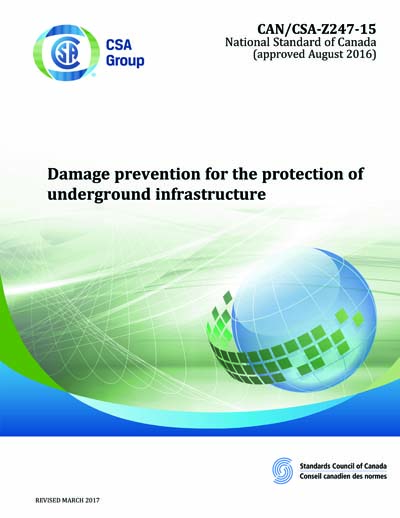Historical
CSA Z247-2015
Z247-15 - Damage prevention for the protection of underground infrastructure
Preface
This is the first edition of CSA Z247, Damage prevention for the protection of underground infrastructure. Users of this Standard are reminded that additional and site-specific requirements might be specified by federal, provincial/territorial, or municipal authorities. This Standard should not be considered as a replacement for the requirements contained in any a) applicable federal, provincial/territorial, or municipal statute; or b) regulation, licence, or permit issued pursuant to an applicable statute. Explanatory material and special formatting have been added to clarify the content: an asterisk (*) beside a clause number identifies those clauses for which further information is provided in Annex A.Scope
1.1 This Standard specifies requirements for preventing damage to underground infrastructure. Note: Examples of underground infrastructure include a) oil and gas pipelines; b) electrical and telecommunication cables; and c) water and sewer lines. 1.2 This Standard applies to ground disturbance in proximity to existing, deactivated, abandoned in-place, or reserved for future use underground infrastructure. 1.3 This Standard identifies the damage prevention process and outlines its key elements that, when consistently applied, will prevent and reduce damage to all underground infrastructure and enhance public safety. 1.4* This Standard does not apply to infrastructure that is a) above grade; or Note: Examples of above-grade infrastructure include overhead wires, pole- or tower-mounted devices, and antennas. b) installed below grade for private use on private land, where the landowner is both the excavator and the infrastructure owner. Note: With respect to the above exemptions, this Standard may still provide valuable guidance. The exempted user of this Standard can determine the applicability and suitability of the guidance provided by this Standard. 1.5 In this Standard, shall is used to express a requirement, i.e., a provision that the user is obliged to satisfy in order to comply with the standard; should is used to express a recommendation or that which is advised but not required; and may is used to express an option or that which is permissible within the limits of the standard. Notes accompanying clauses do not include requirements or alternative requirements; the purpose of a note accompanying a clause is to separate from the text explanatory or informative material. Notes to tables and figures are considered part of the table or figure and may be written as requirements. Annexes are designated normative (mandatory) or informative (non-mandatory) to define their application.Content Provider
CSA America, Inc. [csa]






